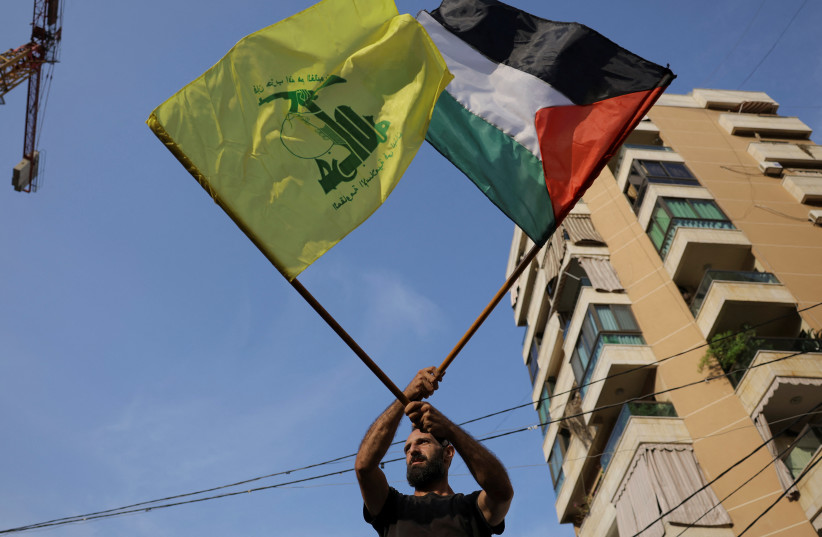After Hamas launched its murderous invasion from Gaza on October 7, Hezbollah began attacks from the North, which appeared to herald a multi-front war against Israel, in accord with a wider Iranian plan to “unify the arenas” against the Jewish state.
Essentially this meant that Tehran wanted to coalesce attacks by several groups such as Hamas, Hezbollah, the Houthis, Palestinian Islamic Jihad as well as groups in Syria and Iraq against Israel. Iran knows it can’t defeat the Jewish state in a conventional war, but thinks it can challenge Israel by coordinating numerous types of threats against it.
Hezbollah is the strongest Iranian proxy with up to 150,000 rockets and missiles, and thousands of drones and anti-tank missiles, as well as other munitions. Iran’s own media now provides an insight into Hezbollah accomplishments over 50 days of fighting, which included daily attacks on Israel using rockets, mortars and anti-tank missiles. More recently they involved the heavy missile called “Burkan” which has a large warhead. Iran has frequently praised and highlighted these attacks.
The Iranian article at Tasnim News, which is close to the Iranian Revolutionary Guard Corps, the IRGC, says that “what is certain is that the first phase of the resistance conflict with the Zionist enemy during the Gaza war has ended, and if the Zionists resume their aggression after the end of the temporary ceasefire, we will enter the second phase of the war, which may be more severe than the first phase.”

Hezbollah has said it is ready for the next phase of the war, with the Lebanese terrorist organization’s Secretary General Naim Qassem saying that Israel “will see something from the resistance that they have not seen before,” the report said.
Hezbollah, a new front?
Hezbollah can already claim to have opened another front against Israel, and was quick to do so, likely on orders from Iran. “Hezbollah clearly declared that it will not be neutral in this war and Hezbollah fighters have fought the enemy side by side with Palestinian fighters,” Iran’s Tasnim says.
Iran has also praised Hezbollah for the volume of its attacks, which it says “caused Israelis to flee.” This refers to the 40 Israeli communities evacuated after the attacks began, including the city of Kiryat Shmona.
“In this way, it can be said that Hezbollah played a significant role in forcing the Zionist regime to accept the ceasefire,” the report said.
THE HEZBOLLAH attacks also helped to illustrate the “unity of the resistance areas,” with Iran’s own media noting that “Hezbollah’s direct entry into the battlefield against the Zionist enemy was a prelude to the entry of other fronts, including the resistance of Iraq and Yemen… to the extent that none of the American bases in Iraq and Syria were spared the repeated attacks of the Iraqi resistance.”
Therefore, Iran was able to bring together all these proxies during the conflict.
The report says that Hezbollah’s attacks also increased its political popularity in Lebanon. This means that the calculation to enter the war is important because it was not just about supporting Hamas but also about increasing Iran’s political influence in Lebanon, Iraq and Syria.
Another aspect was Iran’s hopes to emphasize that Sunni and Shi’ite organizations are working together now in this conflict. Hamas and Palestinian Islamic Jihad are made up of Palestinian Sunnis, while Hezbollah and Iranian groups in Iraq are made up of Shi’ites.
“Although the American axis has been trying to create sectarian differences between the Muslims of the region for the past few decades and tried to put Hezbollah as a Shia resistance group against the Sunnis… today we see how the Sunni circles praise the dedication and zeal of the Shi’ites of Hezbollah to defend the Sunni Muslims of Palestine,” the report says. This is important because it is designed to heal the wounds of fighting in Syria and Iraq over the last two decades.
Lastly, Iran praises Hezbollah for creating an “equation” that will make it harder for fighting to resume in Gaza. “Whether the war in Gaza is stopped at the current stage or continues…Israel will face a new set of Hezbollah equations,” the report says, hinting at Hezbollah escalation if fighting resumes.
